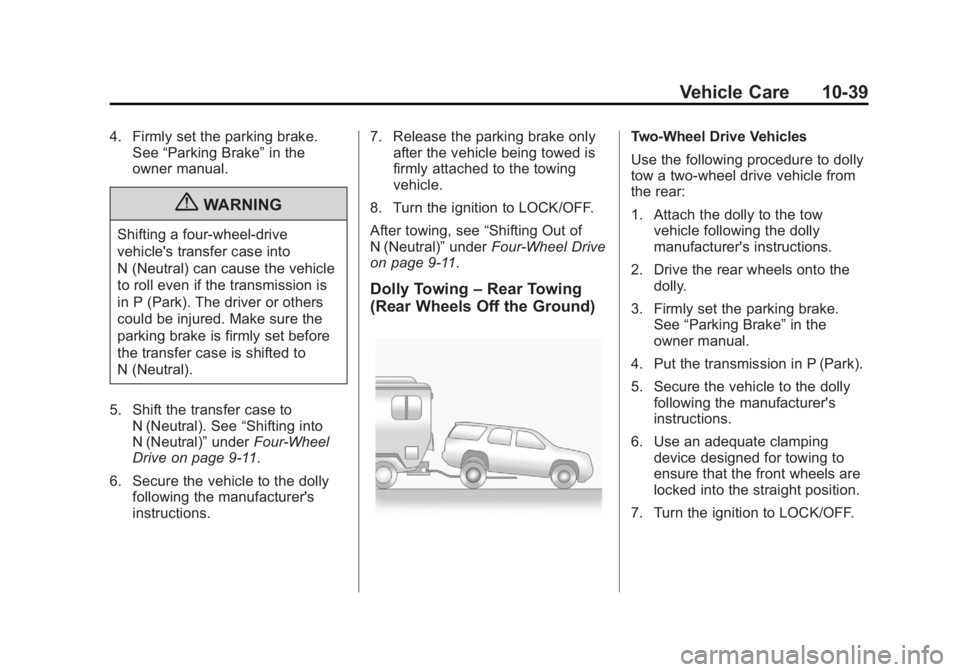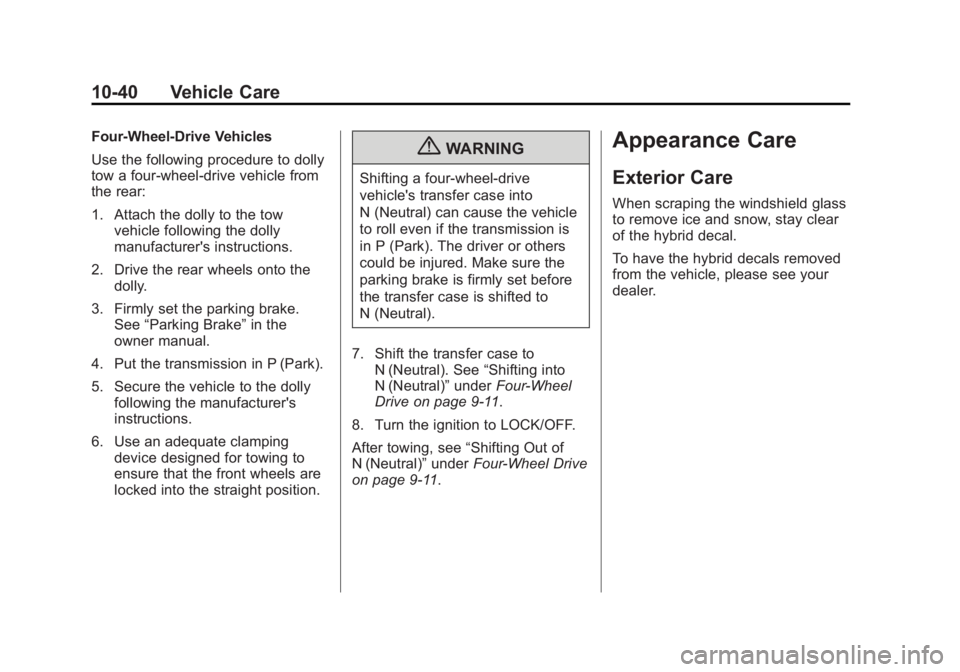Page 81 of 94

Vehicle Care 10-37Four-Wheel Drive Vehicles
Use the following procedure to
dinghy tow a four-wheel drive
vehicle:
1. Position the vehicle being towed
behind the tow vehicle and shift
the transmission to P (Park).
2. Turn the engine off and firmly set
the parking brake. See “ Parking
Brake ” in the owner manual.
3. Securely attach the vehicle
being towed to the tow vehicle. { WARNINGShifting a four-wheel-drive
vehicle's transfer case into
N (Neutral) can cause the vehicle
to roll even if the transmission is
in P (Park). The driver or others
could be injured. Make sure the
parking brake is firmly set before
the transfer case is shifted to
N (Neutral).
4. Shift the transfer case to
N (Neutral). See “ Shifting into
N (Neutral) ” under Four-Wheel
Drive on page 9 ‑ 11 for the
proper procedure to select the
Neutral position for the vehicle.
5. Release the parking brake only
after the vehicle being towed is
firmly attached to the towing
vehicle. 6. For vehicles without a column
lock, turn the ignition to LOCK/
OFF and remove the key.
The steering wheel will still turn.
7. For vehicles with a column lock,
remove the DLIS fuse from the
engine compartment fuse block
and turn the ignition to the
ACC/ACCESSORY position.
If the ignition is turned to the
ON/RUN position, the battery
will be drained.
Page 82 of 94
10-38 Vehicle Care Dolly Towing – Front Towing
(Front Wheels Off the Ground) Two-Wheel Drive Vehicles
Notice: If a two-wheel-drive
vehicle is towed with the rear
wheels on the ground, the
transmission could be damaged.
The repairs would not be covered
by the vehicle warranty. Never
tow the vehicle with the rear
wheels on the ground. Two-wheel drive vehicles should not
be towed with the rear wheels on
the ground. Two-wheel drive
transmissions have no provisions
for internal lubrication while being
towed.
To dolly tow a two ‐ wheel ‐ drive
vehicle, the vehicle must be towed
with the rear wheels on the dolly.
See “ Rear Towing (Rear Wheels Off
the Ground) ” later in this section for
more information. Four-Wheel Drive Vehicles
Use the following procedure to dolly
tow a four-wheel drive vehicle from
the front:
1. Attach the dolly to the tow
vehicle following the dolly
manufacturer's instructions.
2. Drive the front wheels onto the
dolly.
3. Shift the transmission to
P (Park).
Page 83 of 94

Black plate (39,1)Cadillac Escalade Hybrid - 2011
Vehicle Care 10-394. Firmly set the parking brake.
See “ Parking Brake ” in the
owner manual.
{ WARNINGShifting a four-wheel-drive
vehicle's transfer case into
N (Neutral) can cause the vehicle
to roll even if the transmission is
in P (Park). The driver or others
could be injured. Make sure the
parking brake is firmly set before
the transfer case is shifted to
N (Neutral).
5. Shift the transfer case to
N (Neutral). See “ Shifting into
N (Neutral) ” under Four-Wheel
Drive on page 9 ‑ 11 .
6. Secure the vehicle to the dolly
following the manufacturer's
instructions. 7. Release the parking brake only
after the vehicle being towed is
firmly attached to the towing
vehicle.
8. Turn the ignition to LOCK/OFF.
After towing, see “ Shifting Out of
N (Neutral) ” under Four-Wheel Drive
on page 9 ‑ 11 .
Dolly Towing – Rear Towing
(Rear Wheels Off the Ground) Two ‐ Wheel Drive Vehicles
Use the following procedure to dolly
tow a two-wheel drive vehicle from
the rear:
1. Attach the dolly to the tow
vehicle following the dolly
manufacturer's instructions.
2. Drive the rear wheels onto the
dolly.
3. Firmly set the parking brake.
See “ Parking Brake ” in the
owner manual.
4. Put the transmission in P (Park).
5. Secure the vehicle to the dolly
following the manufacturer's
instructions.
6. Use an adequate clamping
device designed for towing to
ensure that the front wheels are
locked into the straight position.
7. Turn the ignition to LOCK/OFF.
Page 84 of 94

Black plate (40,1)Cadillac Escalade Hybrid - 2011
10-40 Vehicle Care Four ‐ Wheel ‐ Drive Vehicles
Use the following procedure to dolly
tow a four-wheel-drive vehicle from
the rear:
1. Attach the dolly to the tow
vehicle following the dolly
manufacturer's instructions.
2. Drive the rear wheels onto the
dolly.
3. Firmly set the parking brake.
See “ Parking Brake ” in the
owner manual.
4. Put the transmission in P (Park).
5. Secure the vehicle to the dolly
following the manufacturer's
instructions.
6. Use an adequate clamping
device designed for towing to
ensure that the front wheels are
locked into the straight position. { WARNINGShifting a four-wheel-drive
vehicle's transfer case into
N (Neutral) can cause the vehicle
to roll even if the transmission is
in P (Park). The driver or others
could be injured. Make sure the
parking brake is firmly set before
the transfer case is shifted to
N (Neutral).
7. Shift the transfer case to
N (Neutral). See “ Shifting into
N (Neutral) ” under Four-Wheel
Drive on page 9 ‑ 11 .
8. Turn the ignition to LOCK/OFF.
After towing, see “ Shifting Out of
N (Neutral) ” under Four-Wheel Drive
on page 9 ‑ 11 .Appearance Care Exterior Care When scraping the windshield glass
to remove ice and snow, stay clear
of the hybrid decal.
To have the hybrid decals removed
from the vehicle, please see your
dealer.
Page 85 of 94
Black plate (1,1)Cadillac Escalade Hybrid - 2011
Service and Maintenance 11-1
Service and
Maintenance Scheduled Maintenance Scheduled Maintenance . . . . . 11-1
Recommended Fluids,
Lubricants, and Parts Recommended Fluids and
Lubricants . . . . . . . . . . . . . . . . . . 11-2
Scheduled
Maintenance In addition to the scheduled
maintenance services described in
the owner manual, the following
service should be performed. Once a Year
This vehicle has a Tire Sealant and
Compressor Kit. Check the sealant
expiration date printed on the
instruction label of the kit. See Tire
Sealant and Compressor Kit on
page 10 ‑ 24 .
Page 86 of 94
Black plate (2,1)Cadillac Escalade Hybrid - 2011
11-2 Service and Maintenance
Recommended Fluids, Lubricants, and Parts Recommended Fluids and Lubricants Fluids identified below are specific to the hybrid vehicle and can be obtained from your dealer. See the owner
manual for the other fluids and lubricants recommended for the vehicle.
Usage Fluid/Lubricant
Drive Motor/Generator Control
Module (DMCM) Cooling System Always use the pre-mixed 50/50 mixture of de ‐ ionized water and
DEX-COOL ®
(silicate-free) coolant available at your dealer. See Drive
Motor/Generator Control Module (DMCM) Cooling System on page 10 ‑ 9 .
Page 87 of 94
Black plate (1,1)Cadillac Escalade Hybrid - 2011
Technical Data 12-1
Technical Data Vehicle Data Capacities and
Specifications . . . . . . . . . . . . . . 12-2
Engine Drive Belt Routing . . . 12-3
Page 88 of 94
Black plate (2,1)Cadillac Escalade Hybrid - 2011
12-2 Technical Data
Vehicle Data Capacities and Specifications Application Capacities
Metric English
Automatic Transmission* (Pan Removal and Filter
Replacement) 10.9 L 11.5 qt
Cooling System
Drive Motor Generator Control Module Cooling System 2.7 L 2.9 qt
6.0L V8 Engine Cooling System 17.3 L 18.3 qt
Fuel Tank 92.7 L 24.5 gal
*Transmission fluid capacity is approximate. See Automatic Transmission Fluid on page 10 ‑ 6 for information on
checking fluid level.
All capacities are approximate. Recheck fluid level after filling.